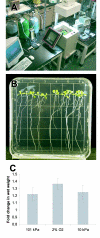Hypobaric biology: Arabidopsis gene expression at low atmospheric pressure
- PMID: 14701916
- PMCID: PMC316301
- DOI: 10.1104/pp.103.032607
Hypobaric biology: Arabidopsis gene expression at low atmospheric pressure
Abstract
As a step in developing an understanding of plant adaptation to low atmospheric pressures, we have identified genes central to the initial response of Arabidopsis to hypobaria. Exposure of plants to an atmosphere of 10 kPa compared with the sea-level pressure of 101 kPa resulted in the significant differential expression of more than 200 genes between the two treatments. Less than one-half of the genes induced by hypobaria are similarly affected by hypoxia, suggesting that response to hypobaria is unique and is more complex than an adaptation to the reduced partial pressure of oxygen inherent to hypobaric environments. In addition, the suites of genes induced by hypobaria confirm that water movement is a paramount issue at low atmospheric pressures, because many of gene products intersect abscisic acid-related, drought-induced pathways. A motivational constituent of these experiments is the need to address the National Aeronautics and Space Administration's plans to include plants as integral components of advanced life support systems. The design of bioregenerative life support systems seeks to maximize productivity within structures engineered to minimize mass and resource consumption. Currently, there are severe limitations to producing Earth-orbital, lunar, or Martian plant growth facilities that contain Earth-normal atmospheric pressures within light, transparent structures. However, some engineering limitations can be offset by growing plants in reduced atmospheric pressures. Characterization of the hypobaric response can therefore provide data to guide systems engineering development for bioregenerative life support, as well as lead to fundamental insights into aspects of desiccation metabolism and the means by which plants monitor water relations.
Figures




References
-
- Andre M, Massimino D (1992) Growth of plants at reduced pressures. Experiments in wheat: technological advantages and constraints. Adv Space Res 12: 97-106 - PubMed
-
- Andre M, Richaux C (1986) Can plants grow in quasi-vacuum? In CELSS 1985 Workshop, Ames Research Center. NASA Publication TM 88215: 395-404
-
- Baker D (1981) The History of Spaceflight. Crown Publishers, Inc., New York
Publication types
MeSH terms
LinkOut - more resources
Full Text Sources
Other Literature Sources
Research Materials

